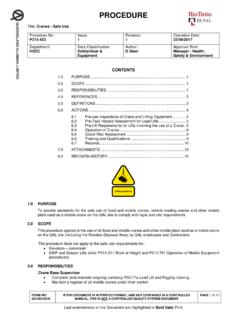Transcription of Choosing the Right Dock Leveler. - Datar Engineering
1 Choosing the Right dock Leveler. Your Guide to Evaluating Your Leveler Needs. S I X S T E P S t o c h o o s i n g t h e r i g h t l eve l e r. T oday, selecting the Right dock leveler for your facility can be more complicated than ever. New models are being introduced. Truck designs are changing. Productivity is critical . And safety is becoming an even bigger issue at docks across the country. There are now three basic types of levelers : hydraulic, mechanical, and power-assisted mechanical units. Each design has its place, depending upon the application, but there are distinct differences between each type. So before you select a leveler for your facility, follow this simple six-step procedure for evaluating your needs. By analyzing these key areas, you'll be able to choose the best equipment for your operation. Here's a brief look at the topics we'll cover in this guide: Yo u r s p e c i f i c n e e d s Maintenance Page 3 Page 10.
2 Maintenance frequency Selecting leveler length Features for ease of Selecting leveler width maintenance Choosing proper capacity Initial vs. lifetime ownership cost Safety Reliability/Durability Page 6 Page 11. Vacant dock drop-off protection Long-term track record of design Cross-traffic safety Quality of construction Free-fall protection Durability features Maintenance safety Ease of operation Manufacturer support Page 8 Page 12. Company reputation Activation and leveler Local service and support positioning Customer training Full-range leveler float Written manufacturer Lip extension/retraction warranties 2. ST E P Co n s i d e r yo u r s p e c i f i c n e e d s . Ddimensions, ifferent operations place different demands on a dock leveler. Make sure that the leveler you choose matches your individual requirements. Consider the types of vehicles that will use your dock , trailer frequency of use and load capacities.
3 All of these factors will help determine the leveler that's best designed for your operation. HIGH CUBE. REFRIGERATED. OVER THE STRAIGHT UPS. CITY ROAD. PICK-UP. 48". Typical trailer types: Truck beds can vary from 20" to 62" high. Longer levelers provide greater flexibility to safely service a wider range of vehicles. Selecting leveler length Consider the type of traffic and activity at your dock when High capacity or high cube trailers. New trailers are selecting a leveler length. It's important to establish a safe, designed to carry more cargo and have 6"-18" lower bed smooth path for forklifts to travel between the dock and the heights than standard trailers. trailer, and truck bed heights can vary dramatically. As a rule of thumb, the greater the distance between dock height and trailer bed height, the longer your levelers should be. Several trends are leading to lower bed heights, increasing the need for longer levelers .
4 Today's trend toward wider, lower, higher-capacity trailers has led to the need for longer levelers . Years ago, 6' leveler lengths were standard. Now, 8' and 10' lengths are common. These levelers can more safely and efficiently serve the newer trailers. Low-profile tires. Trucks using low-profile tires are becoming Air-ride suspensions. More and more air-ride trailers are being increasingly common today. The old standard 24" wheel has used today. They improve driver comfort and help protect been replaced by the " wheel. And tomorrow's standard cargo. But unless specially equipped, the air must be released could be ". This trend means lower trailer bed heights when the truck is parked at the dock to help prevent trailer as much as 5" to 8" lower. walk and ensure safe loading and unloading. The release of Old Standard air can lower the bed height as much as 8", meaning you'll Current Standard Tomorrow's 24" Wheel Standard?
5 Need a longer leveler to safely service these trailers. " Wheel " Wheel NOTE: Even if your facility is not handling low-profile or air-ride trailers now, there's a strong chance that you will be handling these vehicles in the near future. 3. Steep slope can create numerous material handling problems. Forklift hang-ups can occur when the leveler grade is too steep. Short levelers can limit your capabilities. If your leveler is Forklift grade limitations. Different types of material too short, a steep incline or decline can be created. In handling equipment have different grade capabilities. addition to being unsafe for the forklift driver, this can Electric pallet trucks have a 7% maximum grade capability. cause several material handling problems, including: an Electric forklifts are limited to 10% grade and gas-powered inadequate amount of lip on the trailer bed; more wear and forklifts can accommodate up to a 15% grade.
6 Longer tear on forklifts and leveler; slower operations; and levelers let you minimize the slope of the ramp and equipment that can hang-up on the crown that point increase your choice of forklifts. where the leveler deck and lip come together. Note: Leveler lip length is also a consideration when determining leveler length. Once standard 16" lips are now giving way to 18" and 20" lips on new levelers . A longer lip can also be retrofitted to an existing installation to effectively increase the overall length of a leveler. Selecting leveler width accessibility to end loads and below- dock loads, while allowing more maneuvering room for lift trucks. And Choose a leveler width that matches the specific needs of wider levelers provide greater flexibility to meet future your loading dock . In the past, the most common leveler needs as your operation changes. width was 6'. But with the increased demand for maximum capacity, today's trailers average 8'6" wide, and Three standard dock leveler widths are available 6'0", are fully loaded to the end.
7 That's why a wider leveler is 6'6" and 7'0". In most cases, the widest leveler gives you usually a better choice. Wider levelers provide better more flexibility for nominal extra cost. A leveler that is too narrow can create interference Wider levelers offer greater access for below- dock 4 for forklifts, especially below dock . operations, with minimal pit wall interference. Forklift speed. How fast do your lift trucks usually travel? Choosing leveler capacity The faster they travel, the more punishment your levelers take. Make sure that the leveler you select has the structural strength to handle the gross weight, speed and frequency- Required life expectancy. How long do you plan to keep of-use of your material handling equipment. Choosing the this leveler in operation? Five years? Ten years? Twenty Right capacity will help you get more productive years years? Higher capacity levelers have longer life from your dock leveler investment.
8 Expectancies. Evaluate these factors to help determine Then ask a loading dock specialist proper leveler capacity: about capacity. Frequency of use. Determine how many trucks will be Different manufacturers have different systems for rating leveler serviced at that dock opening per day, and how many loads capacities. ANSI ratings attempt to provide a uniform capacity per truck. This can greatly affect the life expectancy of comparison for the industry. However, these laboratory testing your leveler. procedures are not necessarily the same as real-world conditions, and may not be the best gauge of product performance. That's Gross load weight. Combine the weight of your heaviest why performance-based ratings are the most reliable. Once capacity lift truck, including attachments, plus the weight you've determined the specific information about your of the heaviest load to determine gross weight. application, make sure you talk to an experienced loading dock specialist to help you select the Right capacity leveler for you.
9 FORKLIFT FORKLIFT WEIGHT (EMPTY) And make sure the leveler is warranted for its full life- CAPACITY GAS/LP ELECTRIC expectancy, based on the load and use requirements you specify. (LBS.) WITH BATTERY. 3,000-3,500 5,500-7,400 6,500-9,700. 4,000-4,500 7,400-8,500 9,000-10,500. 5,000 8,500-9,500 10,000-12,000. 6,000 10,000-11,500 11,000-14,000. 7,000 12,500-13,500 12,500-14,500. 8,000 13,000-14,000 14,000-15,500. 9,000 14,000-16,000 NA. 10,000 15,000-17,000 16,500-18,500. 12,000 16,000-19,500 18,000-21,000. 15,000 18,500-22,000 NA The selection of proper leveler capacity should be based on the specific requirements of your application. Angle of leveler ramp. Consider the typical ramp angle for most of your operations. The greater the angle, the more impact force the leveler must absorb. High speed, steep incline, high impact on leveler. Inadequate capacity can cause structural failure. This photo shows how a leveler can bow, or dish, when its capacity cannot handle the weight of the loads it must support.
10 Low speed, minimal incline, low impact NOTE: Free-float interference caused by mechanical on leveler. support legs can also lead to premature structure failure. See Full-Range Leveler Float on page 9 for more details. 5. ST E P Put employee safety first. S afety is one of the most critical considerations when selecting any loading dock equipment. The leveler covers the danger zone that gap between the dock and trailer that is crossed by forklifts up to 100,000. times per year. Make sure the levelers you choose are built for maximum safety in four key areas: (1) vacant dock drop-off protection; (2) free-fall protection; (3) protecting cross-traffic against voids in the floor; and (4) protecting personnel during leveler maintenance. Let's take a look at each of these areas: Vacant dock drop-off protection Cross-traffic safety When no trailer is in place at the dock face, there's a Automatic recycle provides cross-traffic protection against danger that forklifts could accidentally fall from the edge of voids in the floor.




